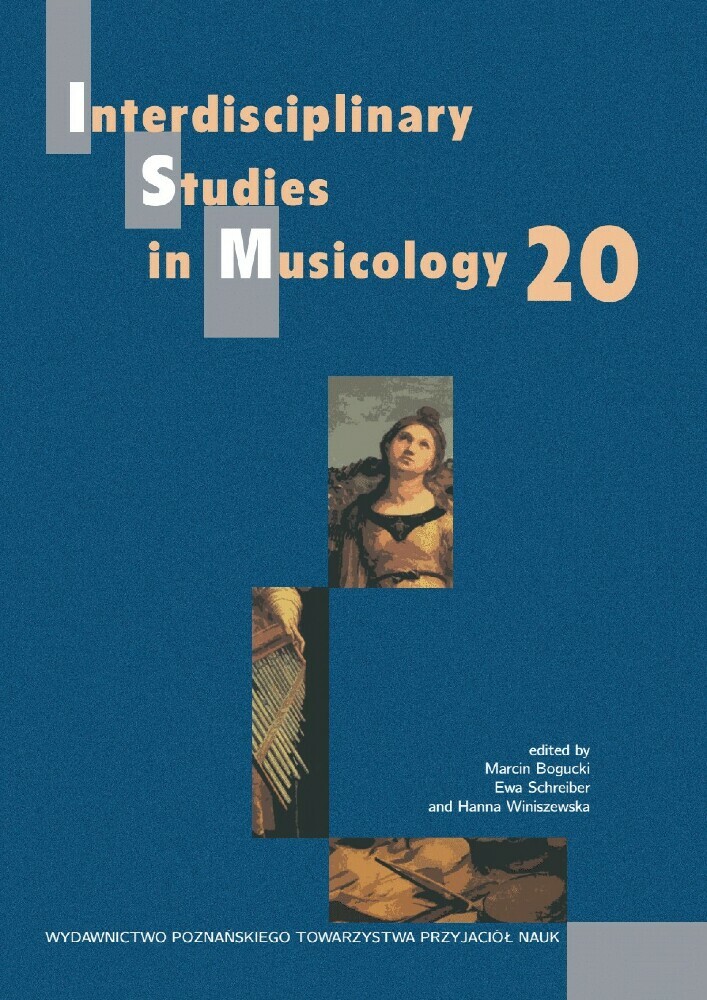Abstrakt
Is it possible to talk of mental patterns underlying aesthetic reflections, and has the constant recurrence of particular ideas in the area of aesthetics some deeper explanation? Structural aesthetics of music is an authorial research conception which enables interpretation of phenomena from the area of history of music aesthetics, and in this way provides its systematised picture. The conception uses the ideas of structural linguistics: binary phonological opposition and the historicalliterary process in the approach of Jan Mukařovský. The article also contains an example of using this conception in relation to the aesthetics of antiquity (sophists, Plato, Aristotle), Descartes and impressionism.
Bibliografia
Hawkes, T. (1983). Strukturalizm i semiotyka [Structuralism and semiotics] (I. Sieradzki, Transl.). Warszawa: Państwowe Wydawnictwo Naukowe.
Holdcroft, D. (1991). Saussure. Signs, System and Arbitrariness. Cambridge: Cambridge University Press.
Jakobson, R., & Halle, M. (1964). Podstawy języka [Fundamentals of language] (L. Zawadzki, Transl). Wrocław: Zakład Narodowy im. Ossolińskich.
Jakobson, R. (1989). W poszukiwaniu istoty języka [In search of the essence of language], vol. 1, vol. 2 (M. R. Mayenowa, Ed.). Warszawa: PIW.
Jarociński, S. (1966). Debussy a impresjonizm i symbolizm [Debussy, impressionism and symbolism]. Kraków: PWM.
Jarzębska, A. (2018). Spór o piękno muzyki [Debate on the beauty of music]. Toruń: Wydawnictwo Naukowe Uniwersytetu Mikołaja Kopernika.
Lévi-Strauss, C. (1973). Wprowadzenie do twórczości Marcela Maussa [Introduction to the works of Marcel Mauss]. In M. Mauss, Socjologia i antropologia [Sociology and anthropology] (M. Król, K. Pomian, J. Szacki, Transl.), (pp. 11–58). Warszawa: PIW.
Lévi-Strauss C. (2000). Antropologia strukturalna [Structural anthropology] (K. Pomian, Transl.). Warszawa: Wydawnictwo KR.
Lisiecka, K. (2007). Symbolizm w teatrze Maeterlincka i Debussy’ego. O ‘Pelleasie i Melisandzie’ [Symbolism in the theatre of Maeterlinck and Debussy. On ‘Pelleas et Melisande’]. Muzykalia I, Materiały konferencyjne I, Zeszyt francuski (materiały z konferencji muzykologicznej organizowanej przez Stowarzyszenie De Musica, Poznań, 25–26 kwietnia 2007), http://demusica.edu.pl/muzykalia-i-materialy-konferencyjne-1-zeszyt-francuski-1; accessed: 21.11.2020.
Mukařovský, J. (1970). Wśród znaków i struktur. Wybór szkiców [Among signs and structures. Selected essays] (J. Sławiński, Ed.). Warszawa: PIW.
Nowak, A. J. (2002). Świat człowieka. Znak. Wartość. Sztuka [The world of mankind. Sign. Value. Art]. Kraków: Collegium Collumbinum.
Pelc, J. (1982). Wstęp do semiotyki [Introduction to semiotics]. Warszawa: Wiedza Powszechna.
Piaget, J. (1972). Strukturalizm [Structuralism], (S. Cichowicz, Transl.). Warszawa: Wiedza Powszechna.
Saussure, F. de (2002). Kurs językoznawstwa ogólnego [Course in general linguistics], (K. Kasprzyk, Transl., K. Polański, Ed.). Warszawa: Państwowe Wydawnictwo Naukowe.
Saussure, F. de. (2004). Szkice z językoznawstwa ogólnego [Writings in general linguistics], (M. Danielewiczowa, Transl.). Warszawa: Wydawnictwo Akademickie DIALOG.
Szymańska, B. (1980). Co to jest strukturalizm? [What is structuralism?]. Wrocław: PAN.
Weinsberg, A., Kurkowska H. (Eds.). (1979). Językoznawstwo strukturalne [Structural linguistics]. Warszawa: Państwowe Wydawnictwo Naukowe.
Van Wymeersch, B. (1996). L’esthetique musicale de Descartes et le cartésianisme. Revue Philosophique de Louvain, 94(2): 271–293.
Verlaine, P. (1980). Wybór poezji [Selected poems] (M. Jastrun, Transl.). Wrocław: Zakład Narodowy im. Ossolińskich.
Żyłko, B. (2009). Semiotyka kultury. Szkoła tartusko-moskiewska [The semiotics of culture. Tartu-Moscow school]. Gdańsk: Wydawnictwo słowo/obraz terytoria.

